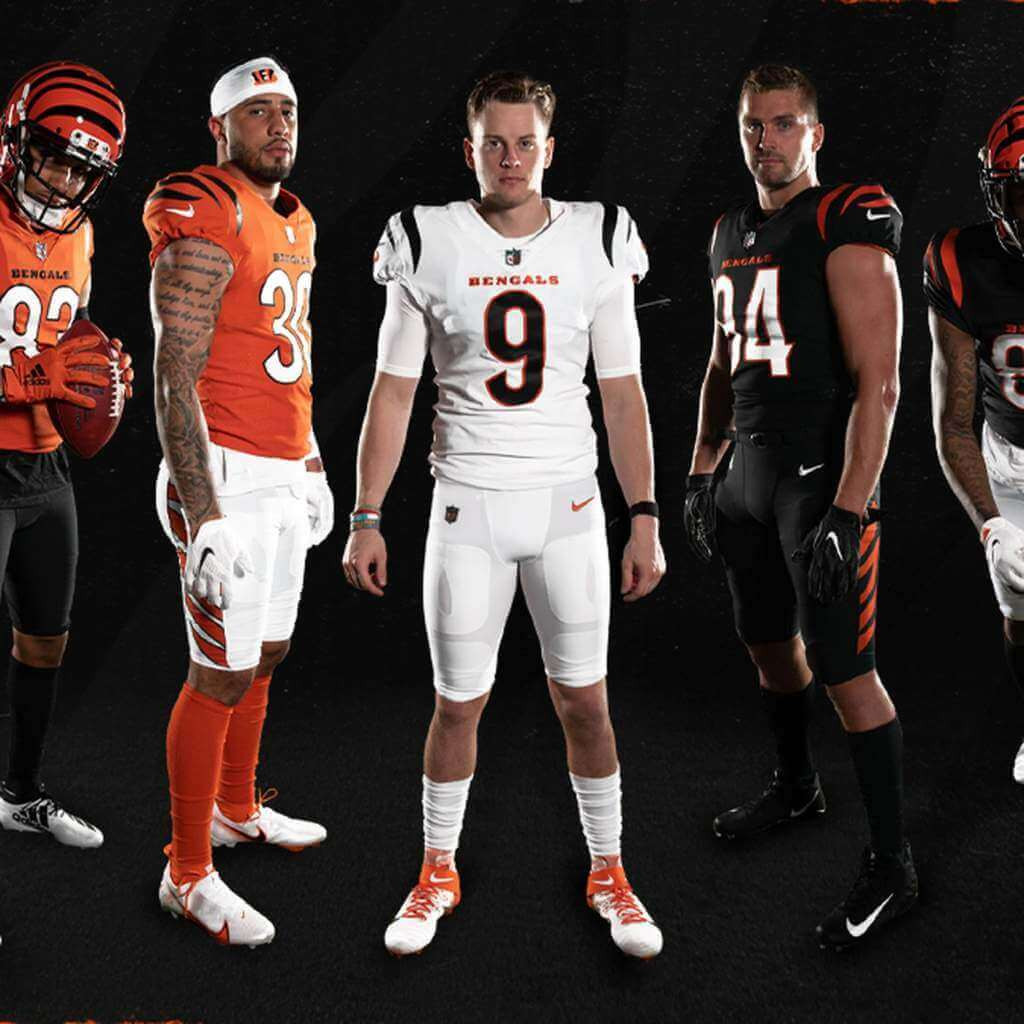The Cincinnati Bengals, a team known for their distinctive tiger stripes and passionate fanbase, boast a uniform history as captivating as their on-field performances. From their inception in 1968, under the guidance of the legendary Paul Brown, to the modern era, the Bengals’ uniforms have undergone significant transformations, reflecting both evolving design trends and the team’s unique identity. This in-depth exploration delves into the Cincinnati Bengals Uniform History, charting the evolution of their iconic look and highlighting key changes that have defined their visual presence in the NFL.
The Paul Brown Era: Conservative Beginnings (1968-1980)

In 1968, Paul Brown established the Cincinnati Bengals as the tenth team in the American Football League (AFL). True to Brown’s traditionalist approach, the initial uniforms were decidedly understated and functional.
1968: Inaugural Uniform
The Bengals debuted with a helmet design that was simple yet effective: a plain orange shell adorned with “BENGALS” in thin black lettering, subtly outlined in white. This minimalist helmet set the tone for the inaugural uniform.
Jerseys were crafted in both white and black. The white jerseys featured black numbers on the front and back, complemented by black/orange/black sleeve stripes and black names on the back (NOB). The black jerseys mirrored this design, using white numbers and white/orange/white sleeve stripes, along with white NOBs. A distinctive feature of these early jerseys, uncommon in professional football at the time, was the absence of TV numbers on the sleeves.
Completing the look were white pants with black/orange/black side stripes. Sock choices varied with jersey color: black/orange/black striped white socks were paired with white jerseys, while white/orange/white striped black socks accompanied the black jerseys.
1969-1971: Minor Adjustments
In 1969, the Bengals introduced warm-weather jerseys featuring slightly separated sleeve stripes for both the white and black versions. These were utilized in milder conditions before transitioning to the standard jerseys as the weather cooled. The separated stripe design was not carried forward into the 1970 season, and the uniforms remained consistent through 1971.
1972-1979: Fabric and Stripe Consistency
By 1972, both mesh (warm weather) and durene (cold weather) jersey fabrics were utilized for both color options, providing players with appropriate attire for varying game conditions. In 1975, a subtle sock stripe modification occurred, with new white socks featuring an orange/black/orange stripe combination being adopted for wear with all jerseys.
The Bengals experimented with separated stripe jerseys again in 1976, adopting them for the entire season. However, in 1977, the black durene jersey made a reappearance for a particularly cold late-season game, highlighting the team’s practical approach to uniform selection based on weather.
1980: Facemasks and TV Numbers
The 1980 season brought two key changes: the facemasks transitioned from gray to black, offering a slightly more modern and aggressive look. More significantly, TV numbers were finally added to the sleeves, aligning the Bengals with standard NFL uniform practices and enhancing viewer identification of players.
The Tiger Stripe Revolution: Radical Redesign (1981-2003)

1981 marked a seismic shift in cincinnati bengals uniform history. The team shed its conservative image for one of the most visually striking and radical designs in the NFL. This overhaul cemented the tiger stripe as the defining element of the Bengals’ brand.
1981: Iconic Tiger Stripes Debut
The helmet retained its orange base color but replaced the “BENGALS” lettering with bold black tiger stripes, instantly creating an iconic and recognizable helmet.
The white jerseys now featured an orange “shoulder loop” design, incorporating black tiger stripes within the loop. Numbers (front, back, and sleeves) were black with orange trim, and NOBs remained black. The black jerseys mirrored this shoulder loop concept, using orange loops with black tiger stripes, and white numbers trimmed in orange.
White pants were introduced with thick orange side stripes, featuring black bengal stripes inset, further emphasizing the tiger theme. Solid orange undersocks completed the bold transformation.
1988-1993: Minor Sock Detail
In 1988, a barely perceptible white wordmark was added to the orange socks, a detail that would disappear again by 1994, indicating a very short-lived design tweak.
1994: 75th NFL Anniversary and Throwback
For the NFL’s 75th anniversary season in 1994, the Bengals, like all teams, wore the NFL75 patch on the left breast of both jerseys. In a nod to their origins, for Week 3, the team sported circa-1968 black uniforms, complete with a black facemask on the original “BENGALS” helmet, offering a vintage contrast to their modern tiger stripe look.
1997-2002: Refinement of Tiger Stripes
1997 brought subtle refinements to the tiger stripe era uniforms. While helmets remained unchanged, white jerseys saw TV numbers move from sleeves to shoulders. The black tiger stripes on the shoulder loops became fewer and thicker, and a running tiger logo was added to the sleeves. Black trim was added to collar and sleeve edges, and NOBs gained orange trim.
Black jerseys also relocated TV numbers to the shoulders, thickened and reduced the tiger stripes on shoulder loops, and added a white-edged running tiger to the sleeves. NOBs on black jerseys also received orange trim. White pants featured thicker inset tiger stripes within the orange side stripes. Socks transitioned from solid orange to solid black, a noticeable color shift.
In 1999, the black sleeve edges on the white jerseys were removed, simplifying the design slightly.
2003: Black Pants Experiment
In 2003, the Bengals briefly experimented with black pants, featuring the same stripe pattern as the white pants. These were worn with black jerseys for the first and last weeks of the season, suggesting an exploration of darker uniform combinations.
Modernizing the Stripes: Contemporary Era (2004-2020)
From 2004 onwards, the Bengals adopted a more modern uniform design, retaining the iconic tiger stripes but updating the overall aesthetic to align with contemporary NFL uniform trends.
2004: Major Uniform Overhaul
With the exception of the helmet, the Bengals’ uniforms underwent significant changes in 2004. Jerseys were redesigned with rounded black numbers on white jerseys and rounded white numbers on black and orange jerseys, all featuring a slight orange drop shadow. Black collars and orange yokes were introduced on white jerseys, while orange collars appeared on black and orange jerseys. A tiger stripe pattern was incorporated into the sleeves, and a tiger-striped “B” logo was placed at the base of the front collar. White side panels were added to black and orange jerseys, adding a distinct element.
Pants now featured white, orange, and black tiger stripes along the sides, available in both white and black variations. Socks were offered in solid black or solid orange, allowing for extensive interchangeability and numerous uniform combinations.
This era saw the Bengals utilize six different uniform combinations in 2004: black/white/black, black/black/orange, white/black/orange, white/white/black, orange/black/orange, and black/black/black, showcasing the versatility of the new uniform set.
2005-2015: Combination Variations and Patches
The Bengals continued to explore various uniform combinations throughout this period. In 2005, they wore a high of eight different combinations. Combinations fluctuated slightly in subsequent years, with five or six combinations being typical.
Throughout these years, the Bengals also wore commemorative patches. In 2008, the league-wide Gene Upshaw memorial patch was worn. A 9/11 tribute ribbon patch was featured in Week 1 of 2011. In 2012, a patch commemorating 50 years of the Pro Football Hall of Fame was worn in Weeks 14 and 15. A 50th Anniversary patch for the Bengals franchise was worn on all jerseys in 2017.
In 2016, the Bengals introduced an all-white Color Rush uniform for a Week 4 game. This monochromatic look featured black block numbers without orange trim and all-white socks, a departure from their standard color schemes.
2017-2020: Flywire Collars and Hose Changes
In 2012, Nike’s flywire collars were incorporated, a design element that was later ditched in 2017. 2019 saw the removal of white sanitary hose. The Bengals continued to cycle through various uniform combinations, including the Color Rush all-white option in select seasons.
Modern Minimalism: The Latest Uniform Evolution (2021-Present)

2021 ushered in the most recent uniform refresh for the Cincinnati Bengals. While the helmet, a beloved and enduring element of their brand, remained unchanged since 1981, jerseys and pants received a significant update.
2021-Present: Streamlined and Simplified
A key change in the 2021 redesign was the removal of TV numbers from all jerseys, creating a cleaner and more minimalist aesthetic. White jerseys featured rounded front and back numbers with an orange outline, black NOBs, an orange “Bengals” wordmark at the collar base, and three black tiger stripes on the sleeves. Black jerseys mirrored this with rounded white numbers outlined in orange, white NOBs, an orange wordmark, and three orange sleeve stripes. Alternate orange jerseys followed the same pattern, using rounded white numbers with a black outline, white NOBs, a black wordmark, and three black sleeve stripes.
Two variations of white pants were introduced: one with black tiger stripes and another with orange tiger stripes. Black pants featured orange tiger stripes. Sock options included all-white, all-black, and all-orange.
The 2021 season saw the Bengals utilize an impressive ten uniform combinations in the regular and postseason, demonstrating the continued versatility of their uniform elements. For Super Bowl LVI, the Bengals opted for a striking combination: black jersey, white pants with orange stripes, and orange socks, paired with the Super Bowl LVI patch.
Conclusion: A Uniform Legacy
The cincinnati bengals uniform history is a compelling narrative of evolution and adaptation. From the conservative beginnings under Paul Brown to the revolutionary tiger stripes and subsequent modernizations, the Bengals’ uniforms have consistently reflected the team’s identity and the changing landscape of NFL design. The current streamlined uniforms honor the team’s iconic elements while embracing a contemporary aesthetic, ensuring the Bengals continue to stand out on the field with a look that is both timeless and distinctly their own.
Thank you to Timmy Brulia for providing the foundational research for this article.
